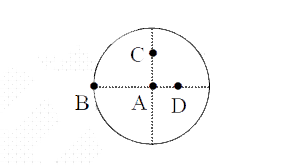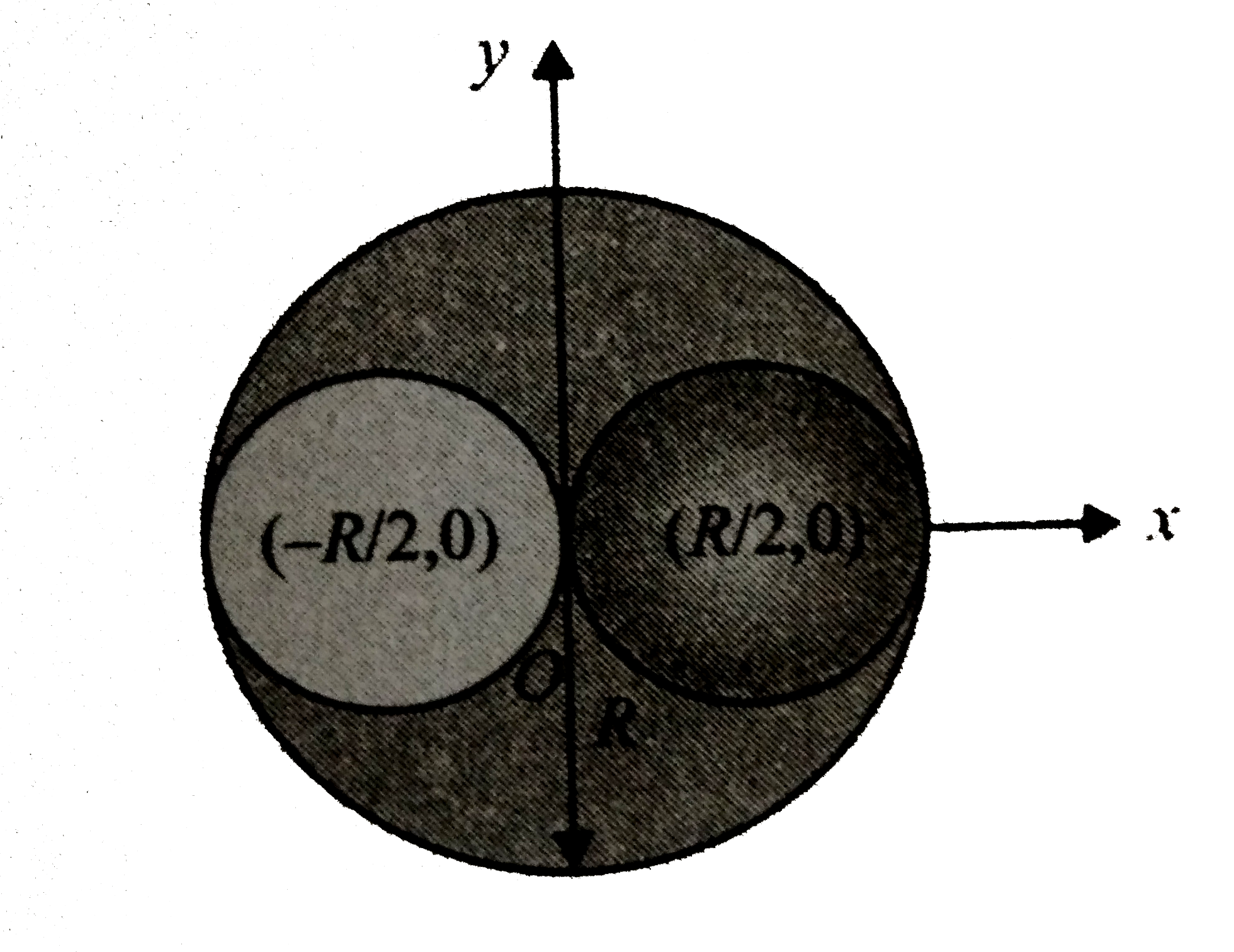Given a uniform disc of mass M and radius R. A small disc of radius R/2 is cut from this disc in such a way that the distance between the centres of the two discs is R/2. Find the moment of inertia of the remaining disc about a diameter of the original disc perpendicular to the line connecting the centres of the two discs
3MR2/32
5MR2/16
11MR2/64
none of these
The correct Answer is:C
To find the moment of inertia of the remaining disc after cutting a smaller disc from a larger uniform disc, we can follow these steps:
Step 1: Determine the mass per unit area of the original disc
The mass per unit area (σ) of the original disc can be calculated using the formula:
σ=MArea of the original disc=MπR2
Step 2: Calculate the mass of the smaller disc
The area of the smaller disc (radius R/2) is:
Area of smaller disc=π(R2)2=πR24
Now, using the mass per unit area, the mass of the smaller disc (M′) is:
M′=σ×Area of smaller disc=MπR2×πR24=M4
Step 3: Calculate the moment of inertia of the original disc about its diameter
The moment of inertia (I1) of the original disc about an axis through its center and along its diameter is given by:
I1=14MR2
Step 4: Calculate the moment of inertia of the smaller disc about its center
The moment of inertia (Icm) of the smaller disc about its own center is:
Icm=14M′(R2)2=14(M4)(R24)=MR264
Step 5: Use the parallel axis theorem to find the moment of inertia of the smaller disc about the axis of the original disc
The distance d between the center of the smaller disc and the center of the original disc is R/2. According to the parallel axis theorem:
I2=Icm+M′d2=MR264+(M4)(R2)2
Calculating the second term:
(M4)(R2)2=M4⋅R24=MR216
Thus, we have:
I2=MR264+MR216=MR264+4MR264=5MR264
Step 6: Calculate the moment of inertia of the remaining disc
The moment of inertia of the remaining disc (Iremaining) is given by:
Iremaining=I1−I2=14MR2−5MR264
Converting 14MR2 to a fraction with a denominator of 64:
14MR2=16MR264
Now substituting:
Iremaining=16MR264−5MR264=11MR264
Final Answer
The moment of inertia of the remaining disc about the specified axis is:
11MR264
The mass per unit area (σ) of the original disc can be calculated using the formula:
σ=MArea of the original disc=MπR2
The area of the smaller disc (radius R/2) is:
Area of smaller disc=π(R2)2=πR24
Now, using the mass per unit area, the mass of the smaller disc (M′) is:
M′=σ×Area of smaller disc=MπR2×πR24=M4
The moment of inertia (I1) of the original disc about an axis through its center and along its diameter is given by:
I1=14MR2
The moment of inertia (Icm) of the smaller disc about its own center is:
Icm=14M′(R2)2=14(M4)(R24)=MR264
The distance d between the center of the smaller disc and the center of the original disc is R/2. According to the parallel axis theorem:
I2=Icm+M′d2=MR264+(M4)(R2)2
Calculating the second term:
(M4)(R2)2=M4⋅R24=MR216
Thus, we have:
I2=MR264+MR216=MR264+4MR264=5MR264
The moment of inertia of the remaining disc (Iremaining) is given by:
Iremaining=I1−I2=14MR2−5MR264
Converting 14MR2 to a fraction with a denominator of 64:
14MR2=16MR264
Now substituting:
Iremaining=16MR264−5MR264=11MR264
The moment of inertia of the remaining disc about the specified axis is:
11MR264
Topper's Solved these Questions
- RIGID BODY DYNAMICS 1Book:CENGAGE PHYSICS ENGLISHChapter:RIGID BODY DYNAMICS 1Exercise:Multiple Correct
Explore 9 Videos
- RIGID BODY DYNAMICS 1Book:CENGAGE PHYSICS ENGLISHChapter:RIGID BODY DYNAMICS 1Exercise:Linked Comprehension
Explore 28 Videos
- RIGID BODY DYNAMICS 1Book:CENGAGE PHYSICS ENGLISHChapter:RIGID BODY DYNAMICS 1Exercise:Subjective
Explore 13 Videos
- PROPERTIES OF SOLIDS AND FLUIDSBook:CENGAGE PHYSICS ENGLISHChapter:PROPERTIES OF SOLIDS AND FLUIDSExercise:INTEGER_TYPE
Explore 2 Videos
- RIGID BODY DYNAMICS 2Book:CENGAGE PHYSICS ENGLISHChapter:RIGID BODY DYNAMICS 2Exercise:Interger
Explore 2 Videos
Similar Questions
A uniform disc (of mass M and radius a) has a hole (of radius b) drilled through it. The centre of the hole is at a distance c from the centre of the original disc. What is the moment of inertia of the disc about an axis through the centre of the disc and perpendicular to its plane ?
View SolutionA disc of radis R is cut out from a larger disc of radius 2R in such a way that the edge of the hole touches the edge of the disc. Locate the centre of mass of the residual disc.
View SolutionA disc of radius r is cut from a larger disc of radius 4r in such a way that the edge of the hole touches the edge of the disc. The centre of mass of the residual disc will be a distance from centre of larger disc :-
View SolutionA disc of radius r is cut from a larger disc of radius 4r in such a way that the edge of the hole touches the edge of the disc. The centre of mass of the residual disc will be a distance from centre of larger disc :-
View SolutionThe moment of inertia of a uniform semicircular disc of mass M and radius r about a line perpendicular to the plane of the disc through the center is
View SolutionFrom a uniform circular disc of mass M and radius R a small circular disc of radius R/2 is removed in such a way that both have a common tangent. Find the distance of centre of mass of remaining part from the centre of original disc.
View SolutionA small disc of radius 2cm is cut from a disc of radius 6cm. If the distance their centers is 3.2cm, what is the shift in the center of mass of the disc?
View SolutionA circular hole is cut from a disc of radius 6 cm in such a way that the radius of the hole is 1 cm and the centre of 3 cm from the centre of the disc. The distance of the centre of mass of the remaining part from the centre of the original disc is
View SolutionThe moment of inertia of a uniform circular disc is maximum about an axis perpendicular to the disc and passing through -

View SolutionFigure shows a uniform disc of radius R, from which a hole of radius R2 has been cut out from left of the centre and is placed on the right of the centre of the disc. Find the CM of the resulting disc.

View Solution